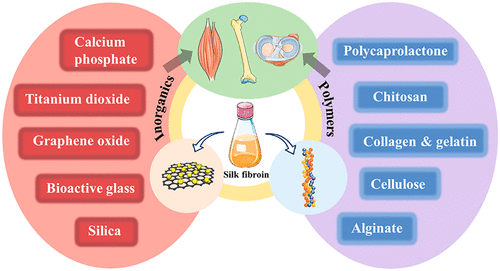当前位置:
X-MOL 学术
›
ACS Appl. Bio Mater.
›
论文详情
Our official English website, www.x-mol.net, welcomes your feedback! (Note: you will need to create a separate account there.)
Bioactive Silk Fibroin-Based Hybrid Biomaterials for Musculoskeletal Engineering: Recent Progress and Perspectives
ACS Applied Bio Materials ( IF 4.7 ) Pub Date : 2021-08-09 , DOI: 10.1021/acsabm.1c00654 Rongjie Wu 1, 2 , Haotao Li 1, 2 , Yuliang Yang 3 , Qiujian Zheng 1 , Shengliang Li 3 , Yuanfeng Chen 1, 4
ACS Applied Bio Materials ( IF 4.7 ) Pub Date : 2021-08-09 , DOI: 10.1021/acsabm.1c00654 Rongjie Wu 1, 2 , Haotao Li 1, 2 , Yuliang Yang 3 , Qiujian Zheng 1 , Shengliang Li 3 , Yuanfeng Chen 1, 4
Affiliation

|
Musculoskeletal engineering has been considered as a promising approach to customize regenerated tissue (such as bone, cartilage, tendon, and ligament) via a self-healing performance. Recent advances have demonstrated the great potential of bioactive materials for regenerative medicine. Silk fibroin (SF), a natural polymer, is regarded as a remarkable bioactive material for musculoskeletal engineering thanks to its biocompatibility, biodegradability, and tunability. To improve tissue-engineering performance, silk fibroin is hybridized with other biomaterials to form silk-fibroin-based hybrid biomaterials, which achieve superior mechanical and biological performance. Herein, we summarize the recent development of silk-based hybrid biomaterials in musculoskeletal tissue with reasonable generalization and classification, mainly including silk fibroin-based inorganic and organic hybrid biomaterials. The applied inorganics are composed of calcium phosphate, graphene oxide, titanium dioxide, silica, and bioactive glass, while the polymers include polycaprolactone, collagen (or gelatin), chitosan, cellulose, and alginate. This article mainly focuses on the physical and biological performances both in vitro and in vivo study of several common silk-based hybrid biomaterials in musculoskeletal engineering. The timely summary and highlight of silk-fibroin-based hybrid biomaterials will provide a research perspective to promote the further improvement and development of silk fibroin hybrid biomaterials for improved musculoskeletal engineering.
中文翻译:

用于肌肉骨骼工程的生物活性丝素蛋白基混合生物材料:最新进展和展望
肌肉骨骼工程被认为是一种通过自我修复性能定制再生组织(如骨骼、软骨、肌腱和韧带)的有前途的方法。最近的进展证明了生物活性材料在再生医学方面的巨大潜力。丝素蛋白 (SF) 是一种天然聚合物,由于其生物相容性、生物降解性和可调节性,被认为是用于肌肉骨骼工程的卓越生物活性材料。为了提高组织工程性能,将丝素蛋白与其他生物材料杂交,形成基于丝素蛋白的杂化生物材料,从而获得优异的机械和生物学性能。在此,我们总结了基于蚕丝的杂化生物材料在肌肉骨骼组织中的最新发展,并进行了合理的概括和分类,主要包括基于丝素蛋白的无机和有机杂化生物材料。应用的无机物由磷酸钙、氧化石墨烯、二氧化钛、二氧化硅和生物活性玻璃组成,而聚合物包括聚己内酯、胶原蛋白(或明胶)、壳聚糖、纤维素和海藻酸盐。本文主要关注物理和生物性能肌肉骨骼工程中几种常见的丝基杂化生物材料的体外和体内研究。对丝素蛋白基杂化生物材料的及时总结和亮点将为促进丝素蛋白杂化生物材料的进一步改进和发展提供研究视角,以改善肌肉骨骼工程。
更新日期:2021-09-20
中文翻译:

用于肌肉骨骼工程的生物活性丝素蛋白基混合生物材料:最新进展和展望
肌肉骨骼工程被认为是一种通过自我修复性能定制再生组织(如骨骼、软骨、肌腱和韧带)的有前途的方法。最近的进展证明了生物活性材料在再生医学方面的巨大潜力。丝素蛋白 (SF) 是一种天然聚合物,由于其生物相容性、生物降解性和可调节性,被认为是用于肌肉骨骼工程的卓越生物活性材料。为了提高组织工程性能,将丝素蛋白与其他生物材料杂交,形成基于丝素蛋白的杂化生物材料,从而获得优异的机械和生物学性能。在此,我们总结了基于蚕丝的杂化生物材料在肌肉骨骼组织中的最新发展,并进行了合理的概括和分类,主要包括基于丝素蛋白的无机和有机杂化生物材料。应用的无机物由磷酸钙、氧化石墨烯、二氧化钛、二氧化硅和生物活性玻璃组成,而聚合物包括聚己内酯、胶原蛋白(或明胶)、壳聚糖、纤维素和海藻酸盐。本文主要关注物理和生物性能肌肉骨骼工程中几种常见的丝基杂化生物材料的体外和体内研究。对丝素蛋白基杂化生物材料的及时总结和亮点将为促进丝素蛋白杂化生物材料的进一步改进和发展提供研究视角,以改善肌肉骨骼工程。


























 京公网安备 11010802027423号
京公网安备 11010802027423号